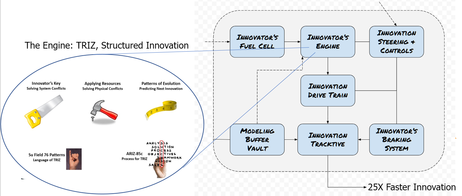84% of Innovation Centers Are Failing
July 5, 2018 By Howard Cooper
ABSTRACT:
Steve Jobs warned on several occasions,
"You can't just ask customers what they want and then try to give that to them. By the time you get it built, they'll want something new."
So, how do you predict the next big-thing the customer will embrace, if the customer doesn’t even know what it is, yet?
So, I put together a system or frame-work of structured innovation methods discovered since the 1960's. I call it the MaxValue Innovation System (MVIS) or my Innovation Vehicle (iVehicle). I have been helping companies modify and adapt MVIS to their particular needs; for their innovation center, their product development teams, or their manufacturing organization. The resulting iVehicle employed by one company may look more like a Tesla Roadster compared to the iVehicle employed by another company which looks more like a Kenmore Semi-truck when compared to the Volkswagen looking iVehicle used by another. The key, here, is each of these iVehicles can carry its owner or owners 5X faster and generating 5X as many hits, rather than misses, as they pursue the world of innovation and product development. [That is an important statement, because 84% of innovation centers set up since 2005 have failed, according to a 2 year study by the Capgemini Consulting group, 2015, “The Innovation Game” (none of these had MVIS.)] But, now you have it. Use it.
ARTICLE TEXT:
Title: "84% of Innovation Centers are Failing, Without Proper Methodology"
Steve Jobs warned on several occasions,
"You can't just ask customers what they want and then try to give that to them. By the time you get it built, they'll want something new."
So, how do you predict the next big-thing the customer will embrace, if the customer doesn’t even know what it is, yet? And, how can you characterize this next big-thing, now, and employ the best Innovation methods and tools throughout the development process, so you can move 5X faster and enjoy 5X the number of customer hits, rather than misses? ‘Want to stay ahead of the competition? Remember what Peter Drucker said, “The firstest with the mostest’ takes the market.”
To do this requires understanding and use of the proper Innovation Methods and Tools, to focus and leverage your thinking and your actions. You may also need to develop some innovation skills, get some iSkills training or iCertification.
Innovation is no different than any other discipline. Consider what has been learned since 1960’s to leverage your success in business management, project management, systems engineering and product development. Without understanding and leveraging that knowledge it is not likely you will succeed in that discipline, against companies and engineers that are using and leveraging that knowledge. Innovation is no different. There have been eight unique innovation methods discovered since the 1960’s. Each method provides its own point of leverage. Each method has its own procedures, principles and tools:
1. Open Innovation & Collaboration
2. Closed Innovation (typified by Nikola Tesla)
3. Lateral Thinking (Ed De Bono)
4. Structured Innovation (TRIZ)
5. Experimental Innovation (typified by Thomas Edison)
6. Natural (by nature) innovation
7. Diamond PM
8. Disruptive Innovation
Can the people spending your innovation dollars, today, explain more than one or two of these valuable methods and name the tools they use while leveraging that method?
There is so much being said today about data analysis and modeling with Big Data (old information) so that organizations can access near real time insights of what their customers are wanting and using. Big Data analysis has its place, but, understanding what they have been doing, or are now doing, or what they want right now isn't enough. As Henry Ford said, “If I had asked people what they wanted, they would have said faster horses.” Innovating when it comes to new products does not mean providing what they want now, it relies on what they are going to want in the future. You have to look at what they are going to want before they know it themselves. Then provide that to them, before someone else does. There are specific tools and methods for doing this.
Most of my writing and www.i3dayInnovation.com/podcasts focus on sharing these valuable Innovation best practices, methods, patterns, principles, processes and tools, which have been discovered, studied and written about since the 1960’s. Yet, most innovation methods remain pretty much a secret, for two reasons;
1. After we’ve read and we think on the meaning and advantage of a new innovation method or “hack”, we begin thinking, “I know that.”, or, “Wow, that’s simple.” But, “Can his way of thinking be better than mine? I am a good thinker…” And, we begin to negate value of the new idea to the point we don’t every apply it or use it,
2. When a new book on innovation is published, describing a newly discovered method, we forget all about the older methods, thinking they have been replaced by the new. Such was the case with Clayton Christensen introducing his scholarly written series of books, over the last decade, on Disruptive Innovation. Each book was a smash hit and now that’s all we read about or talk about. We forget that Disruptive Innovation does not obsolete the usefulness nor purpose of Open Innovation. Likewise, Closed Innovation, TRIZ, Structured Innovation and other methodologies still have their place and purpose. Disruptive Innovation only complements these older methods and can be synergistic with them to leverage your results. It’s like the various major subsystems of an automobile. Just because we finally discovered “brakes” and some associated “braking controls” for innovation (Disruptive Innovation) it does not negate the need for a “fuel system” (Open Innovation). And just because most of us look at a new system and get all excited about “the Engine,” it does not negate the need of a “Drivetrain” nor need for a “Steering” subsystem.
When I first discovered, in May of 2011 that a couple of these innovation methodologies (TRIZ, Structured Innovation and Ed De Bono’s Lateral Thinking) were very synergistic, I then realized that a great engine and a drivetrain do not a vehicle make! So, I spent the next 5-6 years finding and integrating other innovation methodologies needed to create a complete Innovation System to carry individuals and organizations 25X more productively into the immediate future of innovation and successful product development. I call it the MaxValue Innovation System (MVIS) or my iVehicle. I have been helping companies modify and adapt MVIS to their particular needs; for their innovation center, their product development teams, or their manufacturing organization. The resulting iVehicle employed by one company may look more like a Tesla Roadster compared to the iVehicle employed by another company which looks more like a Kenmore Semi-truck when compared to the Volkswagen looking iVehicle used by another. The key, here, is each of these iVehicles can carry its owner or owners 5X faster and generating 5X as many hits, rather than misses, as they pursue the world of innovation and product development. [That is an important statement, because 84% of innovation centers set up since 2005 have failed, according to a 2 year study by the Capgemini Consulting group, 2015, “The Innovation Game” (none of these had MVIS.)] So, I remind them all, “If you don’t have a system, if you don’t own a complete iVehicle, then you’re still walking.”
Similarly, systems engineers and product development specialists struggle with requirement gaps and fail to find rapid innovative ways to eliminate these risks which too often result in product failures and loss of customer adoption. A structured innovation system can easily mitigate these risks, improving the value of products being developed and gaining wide spread customer adoption.
So, now, in my semi-retirement, I share the MVIS methods with you. Let’s change 84% failures into 84% successes. This will also likely change your career success and catapult you from fear of shut-downs and lay-offs to stable increasing income and secure career success. That’s what it did for me.
Methodical Innovation as “the way” is here to stay. Its 25X faster. 80% of the value of a secret is knowing the secret exists. You can google the rest.
By:
Howard Cooper (Innovation Engineer)
www.i3dayInnovation.com
[email protected]
801-859-2073
Attached files:


